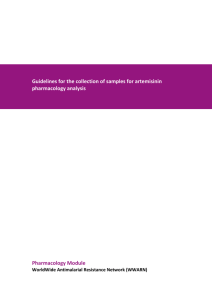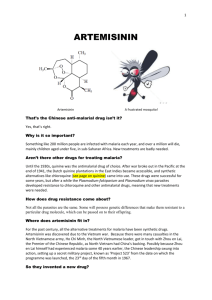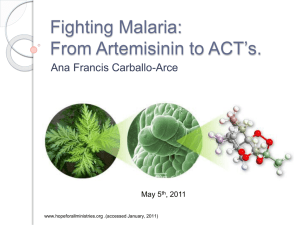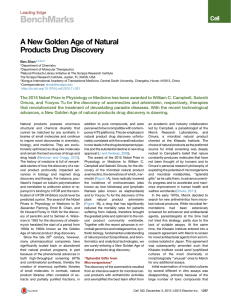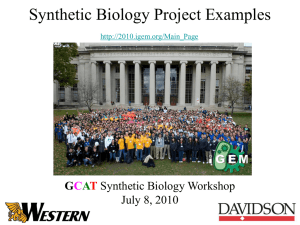Artemisinins target the SERCA of Plasmodium falciparum
advertisement
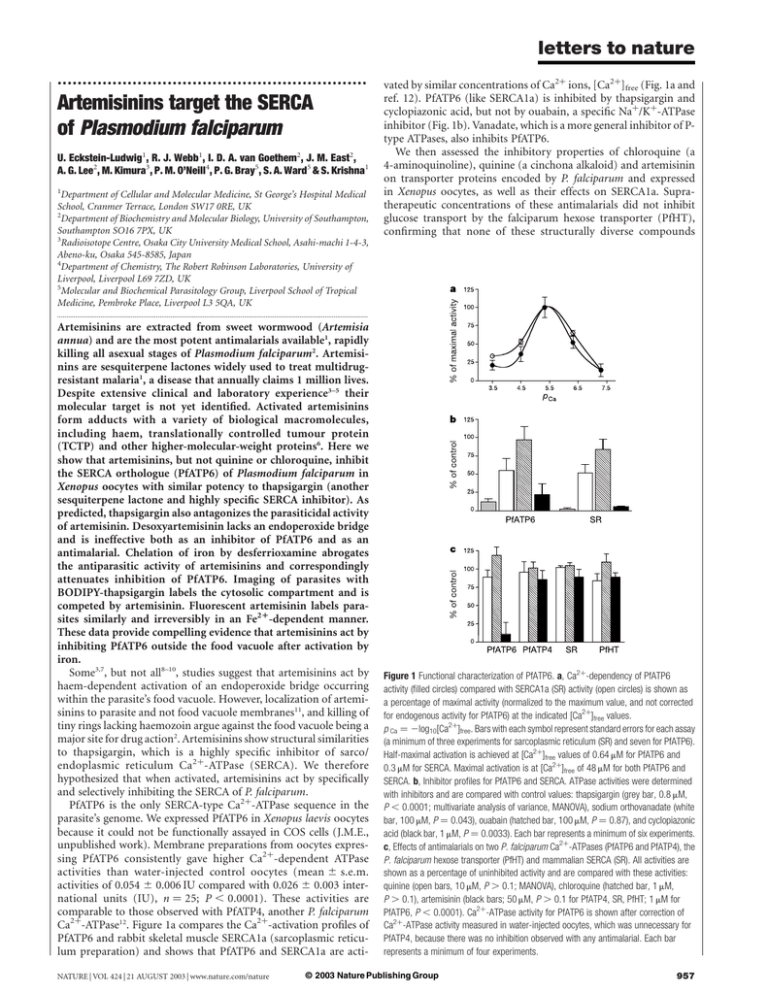
letters to nature .............................................................. Artemisinins target the SERCA of Plasmodium falciparum U. Eckstein-Ludwig1, R. J. Webb1, I. D. A. van Goethem2, J. M. East2, A. G. Lee2, M. Kimura3, P. M. O’Neill4, P. G. Bray5, S. A. Ward5 & S. Krishna1 1 Department of Cellular and Molecular Medicine, St George’s Hospital Medical School, Cranmer Terrace, London SW17 0RE, UK 2 Department of Biochemistry and Molecular Biology, University of Southampton, Southampton SO16 7PX, UK 3 Radioisotope Centre, Osaka City University Medical School, Asahi-machi 1-4-3, Abeno-ku, Osaka 545-8585, Japan 4 Department of Chemistry, The Robert Robinson Laboratories, University of Liverpool, Liverpool L69 7ZD, UK 5 Molecular and Biochemical Parasitology Group, Liverpool School of Tropical Medicine, Pembroke Place, Liverpool L3 5QA, UK vated by similar concentrations of Ca2þ ions, [Ca2þ]free (Fig. 1a and ref. 12). PfATP6 (like SERCA1a) is inhibited by thapsigargin and cyclopiazonic acid, but not by ouabain, a specific Naþ/Kþ-ATPase inhibitor (Fig. 1b). Vanadate, which is a more general inhibitor of Ptype ATPases, also inhibits PfATP6. We then assessed the inhibitory properties of chloroquine (a 4-aminoquinoline), quinine (a cinchona alkaloid) and artemisinin on transporter proteins encoded by P. falciparum and expressed in Xenopus oocytes, as well as their effects on SERCA1a. Supratherapeutic concentrations of these antimalarials did not inhibit glucose transport by the falciparum hexose transporter (PfHT), confirming that none of these structurally diverse compounds ............................................................................................................................................................................. Artemisinins are extracted from sweet wormwood (Artemisia annua) and are the most potent antimalarials available1, rapidly killing all asexual stages of Plasmodium falciparum2. Artemisinins are sesquiterpene lactones widely used to treat multidrugresistant malaria1, a disease that annually claims 1 million lives. Despite extensive clinical and laboratory experience3–5 their molecular target is not yet identified. Activated artemisinins form adducts with a variety of biological macromolecules, including haem, translationally controlled tumour protein (TCTP) and other higher-molecular-weight proteins6. Here we show that artemisinins, but not quinine or chloroquine, inhibit the SERCA orthologue (PfATP6) of Plasmodium falciparum in Xenopus oocytes with similar potency to thapsigargin (another sesquiterpene lactone and highly specific SERCA inhibitor). As predicted, thapsigargin also antagonizes the parasiticidal activity of artemisinin. Desoxyartemisinin lacks an endoperoxide bridge and is ineffective both as an inhibitor of PfATP6 and as an antimalarial. Chelation of iron by desferrioxamine abrogates the antiparasitic activity of artemisinins and correspondingly attenuates inhibition of PfATP6. Imaging of parasites with BODIPY-thapsigargin labels the cytosolic compartment and is competed by artemisinin. Fluorescent artemisinin labels parasites similarly and irreversibly in an Fe21-dependent manner. These data provide compelling evidence that artemisinins act by inhibiting PfATP6 outside the food vacuole after activation by iron. Some3,7, but not all8–10, studies suggest that artemisinins act by haem-dependent activation of an endoperoxide bridge occurring within the parasite’s food vacuole. However, localization of artemisinins to parasite and not food vacuole membranes11, and killing of tiny rings lacking haemozoin argue against the food vacuole being a major site for drug action2. Artemisinins show structural similarities to thapsigargin, which is a highly specific inhibitor of sarco/ endoplasmic reticulum Ca2þ-ATPase (SERCA). We therefore hypothesized that when activated, artemisinins act by specifically and selectively inhibiting the SERCA of P. falciparum. PfATP6 is the only SERCA-type Ca2þ-ATPase sequence in the parasite’s genome. We expressed PfATP6 in Xenopus laevis oocytes because it could not be functionally assayed in COS cells (J.M.E., unpublished work). Membrane preparations from oocytes expressing PfATP6 consistently gave higher Ca2þ-dependent ATPase activities than water-injected control oocytes (mean ^ s.e.m. activities of 0.054 ^ 0.006 IU compared with 0.026 ^ 0.003 international units (IU), n ¼ 25; P , 0.0001). These activities are comparable to those observed with PfATP4, another P. falciparum Ca2þ-ATPase12. Figure 1a compares the Ca2þ-activation profiles of PfATP6 and rabbit skeletal muscle SERCA1a (sarcoplasmic reticulum preparation) and shows that PfATP6 and SERCA1a are actiNATURE | VOL 424 | 21 AUGUST 2003 | www.nature.com/nature Figure 1 Functional characterization of PfATP6. a, Ca2þ-dependency of PfATP6 activity (filled circles) compared with SERCA1a (SR) activity (open circles) is shown as a percentage of maximal activity (normalized to the maximum value, and not corrected for endogenous activity for PfATP6) at the indicated [Ca2þ]free values. p Ca ¼ 2log10[Ca2þ]free. Bars with each symbol represent standard errors for each assay (a minimum of three experiments for sarcoplasmic reticulum (SR) and seven for PfATP6). Half-maximal activation is achieved at [Ca2þ]free values of 0.64 mM for PfATP6 and 0.3 mM for SERCA. Maximal activation is at [Ca2þ]free of 48 mM for both PfATP6 and SERCA. b, Inhibitor profiles for PfATP6 and SERCA. ATPase activities were determined with inhibitors and are compared with control values: thapsigargin (grey bar, 0.8 mM, P , 0.0001; multivariate analysis of variance, MANOVA), sodium orthovanadate (white bar, 100 mM, P ¼ 0.043), ouabain (hatched bar, 100 mM, P ¼ 0.87), and cyclopiazonic acid (black bar, 1 mM, P ¼ 0.0033). Each bar represents a minimum of six experiments. c, Effects of antimalarials on two P. falciparum Ca2þ-ATPases (PfATP6 and PfATP4), the P. falciparum hexose transporter (PfHT) and mammalian SERCA (SR). All activities are shown as a percentage of uninhibited activity and are compared with these activities: quinine (open bars, 10 mM, P . 0.1; MANOVA), chloroquine (hatched bar, 1 mM, P . 0.1), artemisinin (black bars; 50 mM, P . 0.1 for PfATP4, SR, PfHT; 1 mM for PfATP6, P , 0.0001). Ca2þ-ATPase activity for PfATP6 is shown after correction of Ca2þ-ATPase activity measured in water-injected oocytes, which was unnecessary for PfATP4, because there was no inhibition observed with any antimalarial. Each bar represents a minimum of four experiments. © 2003 Nature Publishing Group 957 letters to nature interferes non-specifically with the function of integral membrane proteins of P. falciparum (Fig. 1c). SERCA1a activity was also unaffected by these antimalarials. Apart from PfATP6, PfATP4 is the only Ca2þ-ATPase-like sequence identified in the P. falciparum genome, and defines a non-SERCA subclass of Ca2þ-ATPase that is unique to apicomplexan organisms12. PfATP4 activity was also not inhibited by any of the antimalarials tested. In contrast, Ca2þdependent ATPase activity of PfATP6 was abolished by artemisinin, but not by quinine or chloroquine. These data show that even at relatively high concentrations (1 mM) artemisinin inhibits PfATP6 Figure 2 Properties of artemisinin inhibition. a, The half-maximal inhibition constants (Ki ) for artemisinin (black circles, blue line, 162 ^ 31 nM) and thapsigargin (white circles, red line, 146 ^ 66 nM) were determined. For thapsigargin endogenous Ca2þ-ATPase activity was not subtracted, because K i values for both activities are indistinguishable, and endogenous effects can be neglected. Because of the insensitivity of endogenous activity to artemisinin, this endogenous Ca2þ-ATPase component was determined at high artemisinin concentration (50 mM) in PfATP6-expressing oocytes, and used to correct values. K i values for thapsigargin and artemisinin are not significantly different (P ¼ 0.58). Data are from a minimum of three experiments. The inset shows the determination of K i for SERCA1a-rich rabbit-muscle preparation (K i ¼ 64 nM). b, An isobologram for thapsigargin and artemisinin. The solid line indicates an isobole where drugs act additively and independently. Data points above this line indicate antagonism between drugs, and data below this line would indicate synergy30. FIC is fractional inhibitory concentration. c, The relationship between inhibition of PfATP6 activities determined in Xenopus oocyte preparations is shown compared with inhibitory potencies of artemisinins whose structures are also given. Data are mean values (from a minimum of three independent experiments) with standard error bars, where visible. d, An isobologram for desferrioxamine and artemisinin. Interpretation is as for b. e, PfATP6 activity (corrected for endogenous activity) was determined at two different artemisinin concentrations without (hatched bars) and in presence of desferrioxamine (100 mM, light grey bars). At 500 nM there is significant (P ¼ 0.0093) abrogation of inhibition of PfATP6 by artemisinin. PfATP6 activity (not corrected for endogenous) was also determined at one thapsigargin concentration without (dark grey bars) and in the presence of desferrioxamine (100 mM, black bar). There is no significant difference in inhibitory potency (P . 0.5). Each bar represents at least six experiments. f, An isobologram for chloroquine and Ro 40-4388. Interpretation is as for b. g, An isobologram for artemisinin and Ro 40-4388. Interpretation is as for b. 958 © 2003 Nature Publishing Group NATURE | VOL 424 | 21 AUGUST 2003 | www.nature.com/nature letters to nature with high specificity. No other transporter, including SERCA1a, is inhibited by artemisinin even when used at 50 times (50 mM, Fig. 1c) the concentration used to inhibit PfATP6 activity in this experiment (1 mM). Endogenous (oocyte) Ca2þ-dependent ATPase activity is also resistant to the action of artemisinin (data not shown), demonstrating the unique specificity of artemisinins for PfATP6. To compare the interactions of artemisinin and thapsigargin with PfATP6, we measured inhibitory constants for these compounds in oocytes. Thapsigargin irreversibly inhibits Ca2þ-dependent ATPase activity of SERCA with 1:1 stoichiometry13. Remarkably, the inhibitory profile of artemisinin is exactly superimposable over that of thapsigargin (Fig. 2a), showing that they inhibit PfATP6 with the same potency and stoichiometry in vitro. Artemisinin concentrations that inhibit PfATP6 activity in oocytes (K i < 150 nM) are somewhat higher than those required to kill cultured parasites (median IC50 ¼ 5.47 nM (range IC50 ¼ 0.47 2 27.1 nM) artesunate; n ¼ 256 (ref. 14), and Fig. 2c). This is unsurprising for several reasons. First, there is no information on the concentrations of artemisinins at their subcellular sites of action, although artemisinins are clearly concentrated in infected erythrocytes by several hundred-fold15. Second, the extent of inhibition of PfATP6 required to kill parasites is not yet determined (it may, for example, be less than the K i value determined in oocytes). Third, our in vitro assays are conducted over relatively short periods of time (,15 min) whereas parasite killing is determined after exposure to drug for many hours, and killing is also enhanced in a time-dependent manner2. Fourth, the oocyte membrane preparation that we use has relatively little target protein (about 1%12) in relation to the amount of lipid, favouring sequestration of lipid-soluble components away from target protein. Figure 2a (inset) shows that the K i for thapsigargin on SERCA1arich rabbit-muscle preparations (containing protein 80% of which is SERCA1a) is 64 nM, almost double the IC50 value for lymphocytes (35 nM). As both artemisinin and thapsigargin specifically inhibit PfATP6 after heterologous expression, we predicted that they would exhibit mutual antagonism in cultured parasites. Artemisinin and thapsigargin were administered simultaneously in varying concentrations, and the results plotted as an isobologram (Fig. 2b). The plot shows significant antagonism of the two drugs, indicating that artemisinin specifically inhibits PfATP6 in intact parasites, just as it does in the heterologous expression system. The higher IC50 value for thapsigargin in parasite culture (IC50 ¼ 2.55 mM) compared with the inhibitory constant for PfATP6 in oocyte membranes (K i ¼ 146 nM) may reflect difficulties in accessing intraparasitic PfATP6. This is probably because multiple membranes need to be crossed in parasites, but not in mammalian cells, which are killed by nanomolar concentrations of thapsigargin (discussed below). To confirm that PfATP6 is the target for artemisinins we compared inhibitory constants of a range of artemisinin derivatives against PfATP6 in oocytes, with their ability to kill parasites in vitro. Figure 2c shows results for artemisinin, dihydroartemisinin (the principal antimalarial metabolite of many artemisinin derivatives including artesunate, artemether and artemotil), two other artemisinin derivatives (MP118 and S-X) and arteflene, a less effective semi-synthetic endoperoxide derivative. There is almost perfect correlation between inhibitory potencies of artemisinins for PfATP6 activity and IC50 values from cultured parasites (r 2 ¼ 0.999, Fig. 2c). Those artemisinins that are active antimalarials all contain an endoperoxide bridge16, a key structural feature Figure 3 In vivo labelling with BODIPY-thapsigargin and fluorescent-labelled artemisinin. Cells were incubated in 200 nM BODIPY-thapsigargin (10 min, 37 8C, in presence of 0.025% Pluronic F127), then washed three times and imaged. Pictures were taken after a preliminary scan, to minimize bleaching. Preincubations with unlabelled substances were performed 40 min (37 8C) before incubation with BODIPY-thapsigargin. Artemisinin labelling (500 nM) was performed in absence of Pluronic F127. Scale bars represent 10 mm, unless stated otherwise. a, Fluorescence after incubation in BODIPY-thapsigargin in a single infected cell. b, BODIPY-thapsigargin signal detected after preincubation in thapsigargin (50 mM). c, BODIPY-thapsigargin signal detected after preincubation in artemisinin (50 mM). d, BODIPY-thapsigargin signal detected after preincubation in artemisinin (50 mM) and desferrioxamine (100 mM). e, BODIPY-thapsigargin distribution in the lymphocyte cell line PM-1, showing typical SERCA-type distribution. f, PM-1 cell labelled with BODIPY-thapsigargin after competition with unlabelled thapsigargin (50 mM). g, Distribution of labelled artemisinin in live parasites. Arrows indicate artemisinin in erythrocyte cytosol. h, Chemical structure of labelled artemisinin. i, Low magnification image of live parasites labelled with artemisinin (scale bar represents approximately 30 mm). j, After incubation in labelled artemisinin, cells were washed in 10-fold excess of unlabelled artemisinin and imaged (scale bar represents approximately 30 mm). k, Before incubation in labelled artemisinin, cells were pre-treated with desferrioxamine (100 mM, 30 min), and after labelling washed as in j (scale bar represents approximately 30 mm). NATURE | VOL 424 | 21 AUGUST 2003 | www.nature.com/nature © 2003 Nature Publishing Group 959 letters to nature that generates carbon-centred short-lived radicals through ironmediated catalysis. These intermediate radicals react with and incapacitate target protein(s). Desoxyderivatives are otherwise structurally identical to artemisinins but lack both an endoperoxide bridge and significant antimalarial activity. We predicted that desoxyartemisinin would be a significantly less effective inhibitor of PfATP6. Desoxyartemisinin does not inhibit PfATP6 activity even at concentrations that are two orders of magnitude greater (50 mM) than inhibitory concentrations of artemisinin itself. Again, this observation is consistent with the IC50 value for desoxyartemisinin determined against parasites in vitro (mean 4.85 ^ 1.7 mM). The generation of biologically reactive species from artemisinins depends on cleavage of the peroxide bridge via an iron-dependent mechanism. Consequently, in cultures of P. falciparum, iron deprivation using tight-binding chelators such as desferrioxamine may inhibit antimalarial activity17. We confirmed this antagonistic interaction between iron-deprivation and artemisinins17 by isobologram analysis (Fig. 2d). If our hypothesis is correct, iron chelation should also specifically block the inhibitory effects of artemisinin in our oocyte model. Desferrioxamine abolishes the inhibitory activity of artemisinin on PfATP6 but does not alter the inhibitory properties of thapsigargin (Fig. 2e). On the basis of these observations and published data, we suggest the following model for the antimalarial action of artemisinins. Artemisinins produce carbon-centred free radicals in the presence of catalytic quantities of Fe2þ with the selective targeting of PfATP6 by activated artemisinins being determined by structural features that depend on their sesquiterpene moiety. This proposed mechanism of action contrasts with suggestions that artemisinins may, like chloroquine, bind to haem and interfere with the process of haem crystallization. We therefore tested the relevance of this latter hypothesis using a protease inhibitor (Ro 40-4388)18 that inhibits plasmepsin activity, blocks the first step in haemoglobin degradation and prevents the release of haem in situ. Chloroquine and Ro 40-4388 exhibit mutual antagonism in isobologram analysis (Fig. 2f) as expected if the mode of action of chloroquine stems from binding of the drug to haem, whereas there is neither antagonism nor synergism between Ro 40-4388 and artemisinin (Fig. 2g). This finding confirms that Fe2þ-dependent activation and antimalarial activity of artemisinins is independent of haem binding. To prove a direct interaction between artemisinins and PfATP6, we used a fluorescent derivative of thapsigargin (BODIPY-thapsigargin) to localize it in parasites (Fig. 3a) and demonstrated that competition with an excess of unlabelled thapsigargin abolished this characteristic labelling of parasites (Fig. 3b; for example from 3.7% labelled parasite cells to 0%). Competition was also observed with an excess of artemisinin (Fig. 3c; reducing labelling from 3.7% to 0.84%; P , 0.0001; in one example of three independent experiments), confirming that both artemisinin and thapsigargin interact at a similar site within the parasite. Consistent with the requirement for iron to activate artemisinin, adding desferrioxamine together with artemisinin abolished competition for thapsigargin-binding sites and restored labelling of parasites by BODIPY-thapsigargin (Fig. 3d). To confirm that interaction with PfATP6 was specific for artemisinin, we examined labelling of parasites by thapsigargin in the presence of quinine and found that this labelling was unaffected (not shown). We further confirmed the specificity of these results using BODIPY-thapsigargin to demonstrate the characteristic SERCA pattern of labelling in mammalian cells (PM-1, Fig. 3e)19 and abolition of labelling after preincubation with an excess of unlabelled thapsigargin (Fig. 3f). We next synthesized a fluorescent artemisinin derivative (Fig. 3h) and used this to image the distribution of artemisinin in infected erythrocytes (Fig. 3g). Artemisinin distributes like BODIPYthapsigargin to membranous structures in the cytoplasm of parasites, and does not localize to the parasite food vacuole. Unlike BODIPY-thapsigargin, the fluorescent artemisinin derivative also 960 labels membranous structures within the cytoplasm of the host erythrocyte (Fig. 3g, arrows); these structures are identical to a tubovesicular membranous network that transports artemisinin through the host cell compartment and into the intraerthyrocytic parasite20. Artemisinins are thought to interact initially with a carrier before accessing the tubovesicular membranous network, resulting in a highly efficient delivery pathway20. The fact that similar erythrocytic structures are not observed with BODIPYthapsigargin suggests that a comparable mechanism of delivery to parasites does not exist. Poor penetration of infected erythrocytes by thapsigargin may explain why cultured parasites are relatively insusceptible to the compound, even though inhibitory constants for thapsigargin and artemisinin against PfATP6 expressed in oocytes are similar. We further show in Fig. 3i–k that in vivo binding of artemisinin to parasites is not diminished by an excess of unlabelled artemisinin, unless parasites have been previously exposed to desferrioxamine, when a substantial proportion of labelled artemisinin is removable. Artemisinin forms covalent adducts with four major membraneassociated parasite proteins (relative molecular mass, Mr , 25K, 50K, 65K and .200K) as shown in previous studies21. Only one of these adducts has been investigated (TCTP, 25K)22, and it has not been functionally characterized, so that inhibition of other parasite proteins by artemisinins may still play an as-yet-unspecified role. A dimeric configuration for PfATP6 would predict an adduct of about 280K, consistent with the largest molecular species labelled by artemisinin. Furthermore, exposure to artemisinins rapidly causes swelling of endoplasmic reticulum in parasites, providing a morphological correlate for our proposed site of action23. Withering24 first described the therapeutic use of purple foxglove extracts containing digitalis in 1785, although mammalian Naþ/ Kþ-ATPases were not identified as the drug target of digitoxin, an active compound in these preparations, until 1953 (ref. 25). Our studies suggest that Artemisia extracts, used for an even longer period of time in China, also selectively inhibit a P-type ATPase of the malarial parasite. These results validate P-type ATPases as a drug target of human pathogens. The recent structural solution of mammalian SERCAs will aid in understanding selective toxicity of artemisinins and in producing congeners13,26. A Methods Expression studies For functional studies in X. laevis oocytes the gene encoding PfATP6 was ligated into pMos blue (linearized with EcoRV) using a TA cloning strategy after strengthening of the Kozak consensus (accession number AJ532679). It was then sub-cloned into the Xenopus expression vector pcDNA3.1 (þ) using flanking BamHI and XbaI restriction sites, and linearized with XbaI. Capped complementary RNA was transcribed (T7-mMESSAGE mMACHINE kit, Ambion, Austin, TX)27. X. laevis oocytes were prepared, microinjected, and total membrane preparations harvested after 4–5 days as described12,27. Sarcoplasmic reticulum (enriched for SERCA1a) was prepared from skeletal muscle of New Zealand White rabbits as described28. Ca21-ATPase assay Ca2þ-ATPase activity was measured (10 mg total protein, 25 8C) using a coupled enzyme assay as described28 (CamSpec, Cambridge, UK). [Ca2þ]free was calculated using MaxChelator29. Glucose uptake by PfHT Uptake of permeant D-[U-14C]glucose was measured as described27. Parasites and parasite culture Parasites (clones 3D7, HB3 and K1) were cultured and inhibitory constants for drugs assayed as described2. The effect of the interaction between two antimalarial agents on the growth of P. falciparum in culture was assessed using isobole analysis, as described30. Confocal microscopy Cells (at room temperature) were imaged after labelling with BODIPY-thapsigargin (B-7487, Molecular Probes) using a LSM 510 scanning confocal microscope (Carl Zeiss, Jena, Germany), with excitation at 488 nm attenuated to 0.2–0.5% intensity with an acousto-optical tunable filter. Pinhole size was adjusted to give optical sections ,1.2 mm, emission was detected at .505 nm and analysed with LSM 510 software (v.2.01, Carl Zeiss). For imaging of fluorescent artemisinin, medium-term trophozoite-infected © 2003 Nature Publishing Group NATURE | VOL 424 | 21 AUGUST 2003 | www.nature.com/nature letters to nature erythrocytes were immobilized using poly-L-lysine coated coverslips in a Bioptechs FCS2 perfusion chamber (maintained at 37 8C in normal growth medium). Fluorescent-labelled artemisinin (500 nM) was added 10 min before imaging. Received 20 March; accepted 12 May 2003; doi:10.1038/nature01813. 1. Hien, T. T. & White, N. J. Qinghaosu. Lancet 341, 603–608 (1993). 2. ter Kuile, F., White, N. J., Holloway, P. H., Pasvol, G. & Krishna, S. Plasmodium falciparum: In vitro studies of the pharmacodynamic properties of drugs used for the treatment of severe malaria. Exp. Parasitol. 76, 85–95 (1993). 3. Jefford, C. W. Why artemisinin and certain synthetic peroxides are potent antimalarials. Implications for the mode of action. Curr. Med. Chem. 8, 1803–1826 (2001). 4. Robert, A., Dechy-Cabaret, O., Cazelles, J. & Meunier, B. From mechanistic studies on artemisinin derivatives to new modular antimalarial drugs. Acc. Chem. Res. 35, 167–174 (2002). 5. Olliaro, P. L., Haynes, R. K., Meunier, B. & Yuthavong, Y. Possible modes of action of the artemisinintype compounds. Trends Parasitol. 17, 122–126 (2001). 6. Meshnick, S. R. Artemisinin: mechanisms of action, resistance and toxicity. Int. J. Parasitol. 32, 1655–1660 (2002). 7. Pandey, A. V., Tekwani, B. L., Singh, R. L. & Chauhan, V. S. Artemisinin, an endoperoxide antimalarial, disrupts the hemoglobin catabolism and heme detoxification systems in malarial parasite. J. Biol. Chem. 274, 19383–19388 (1999). 8. Haynes, R. K. et al. Artemisinin antimalarials do not inhibit hemozoin formation. Antimicrob. Agents Chemother. 47, 1175 (2003). 9. O’Neill, P. et al. Biomimetic Fe(II)-mediated degradation of arteflene (Ro-42–1611). The first EPR spin-trapping evidence for the previously postulated secondary carbon-centered cyclohexyl radical. J. Org. Chem. 65, 1578–1582 (2000). 10. Hawley, S. R. et al. Relationship between antimalarial drug activity, accumulation, and inhibition of heme polymerization in Plasmodium falciparum in vitro. Antimicrob. Agents Chemother. 42, 682–686 (1998). 11. Ellis, D. S. et al. The chemotherapy of rodent malaria, XXXIX. Ultrastructural changes following treatment with artemisinine of Plasmodium berghei infection in mice, with observations of the localization of [3H]-dihydroartemisinine in P. falciparum in vitro. Ann. Trop. Med. Parasitol. 79, 367–374 (1985). 12. Krishna, S. et al. Expression and functional characterization of a Plasmodium falciparum Ca2þ-ATPase (PfATP4) belonging to a subclass unique to apicomplexan organisms. J. Biol. Chem. 276, 10782–10787 (2001). 13. Toyoshima, C. & Nomura, H. Structural changes in the calcium pump accompanying the dissociation of calcium. Nature 418, 605–611 (2002). 14. Price, R. et al. The pfmdr1 gene is associated with a multidrug-resistant phenotype in Plasmodium falciparum from the western border of Thailand. Antimicrob. Agents Chemother. 43, 2943–2949 (1999). 15. Gu, H. M., Warhurst, D. C. & Peters, W. Uptake of [3H] dihydroartemisinine by erythrocytes infected with Plasmodium falciparum in vitro. Trans. R. Soc. Trop. Med. Hyg. 78, 265–270 (1984). 16. Haynes, R. K. Artemisinin and derivatives: the future for malaria treatment? Curr. Opin. Infect. Dis. 14, 719–726 (2001). 17. Meshnick, S. R. et al. Iron-dependent free radical generation from the antimalarial agent artemisinin (qinghaosu). Antimicrob. Agents Chemother. 37, 1108–1114 (1993). 18. Bray, P. G., Mungthin, M., Ridley, R. G. & Ward, S. A. Access to hematin: the basis of chloroquine resistance. Mol. Pharmacol. 54, 170–179 (1998). 19. Simpson, P. B. & Russell, J. T. Role of sarcoplasmic/endoplasmic-reticulum Ca2þ-ATPases in mediating Ca2þ waves and local Ca2þ-release microdomains in cultured glia. Biochem. J. 325, 239–247 (1997). 20. Akompong, T., VanWye, J., Ghori, N. & Haldar, K. Artemisinin and its derivatives are transported by a vacuolar-network of Plasmodium falciparum and their anti-malarial activities are additive with toxic sphingolipid analogues that block the network. Mol. Biochem. Parasitol. 101, 71–79 (1999). 21. Asawamahasakda, W., Ittarat, I., Pu, Y. M., Ziffer, H. & Meshnick, S. R. Reaction of antimalarial endoperoxides with specific parasite proteins. Antimicrob. Agents Chemother. 38, 1854–1858 (1994). 22. Bhisutthibhan, J. et al. The Plasmodium falciparum translationally controlled tumor protein homolog and its reaction with the antimalarial drug artemisinin. J. Biol. Chem. 273, 16192–16198 (1998). 23. Ono, T. et al. Degenerative changes in morphology of Plasmodium falciparum induced by artemether in vitro. Jpn J. Parasitol. 40, 587–595 (1991). 24. Allen, D. G., Eisner, D. A. & Wray, S. C. Birthday present for digitalis. Nature 316, 674–675 (1985). 25. Schatzmann, H.-J. Herzglykoside als Hemmstoffe für den aktiven Kalium- und Natriumtransport durch die Erythrocytenmembran. Helv. Physiol. Acta 11, 346–354 (1953). 26. Toyoshima, C., Nakasako, M., Nomura, H. & Ogawa, H. Crystal structure of the calcium pump of sarcoplasmic reticulum at 2.6 Å resolution. Nature 405, 647–655 (2000). 27. Woodrow, C. J., Penny, J. I. & Krishna, S. Intraerythrocytic Plasmodium falciparum expresses a highaffinity facilitative hexose transporter. J. Biol. Chem. 274, 7272–7277 (1999). 28. East, J. M. Purification of a membrane protein (Ca2þ/Mg2þ-ATPase) and its reconstitution into lipid vesicles. Methods Mol. Biol. 27, 87–94 (1994). 29. Bers, D. M., Patton, C. W. & Nuccitelli, R. A practical guide to the preparation of Ca2þ buffers. Methods Cell Biol. 40, 3–29 (1994). 30. Berenbaum, M. C. A method for testing for synergy with any number of agents. J. Infect. Dis. 137, 122–130 (1978). Acknowledgements We thank T. Joët and A.-C. Uhlemann for discussions, P. Wünnenberg for technical assistance, A. Craig for a P. falciparum cDNA library and K. Tanabe for the P. falciparum genomic clone 3L6. We thank the charity Hope (Wessex Medical Trust) for financial support of J.M. East, and T. Bolton for access to confocal microscopy. U. E.-L. was funded by the Deutsche Forschungsgemeinschaft, S.A.W. and P.G.B. are funded by the Wellcome Trust and S.K. holds an MRC (UK) grant. This paper is dedicated to the memory of G. Cowan. Competing interests statement The authors declare competing financial interests: details accompany the paper on www.nature.com/nature. Correspondence and requests for materials should be addressed to S.K. (s.krishna@sghms.ac.uk). NATURE | VOL 424 | 21 AUGUST 2003 | www.nature.com/nature .............................................................. Feedback regulation of MAPK signalling by an RNA-binding protein Reiko Sugiura1, Ayako Kita1, Yasuhito Shimizu1, Hisato Shuntoh2, Susie O. Sio1* & Takayoshi Kuno1 1 Division of Molecular Pharmacology and Pharmacogenomics, Department of Genome Sciences, Kobe University Graduate School of Medicine, Kobe 650-0017, Japan 2 Faculty of Health Science, Kobe University School of Medicine, 7-10-2 Tomogaoka, Suma-ku, Kobe 654-0142, Japan * Present address: Department of Pharmacology, College of Medicine, University of the Philippines Manila, Manila 1000, Philippines ............................................................................................................................................................................. Mitogen-activated protein kinases (MAPKs) are evolutionarily conserved enzymes that convert extracellular signals into various outputs such as cell growth, differentiation and cell death1–4. MAPK phosphatases selectively inactivate MAPKs by dephosphorylating critical phosphothreonine and phosphotyrosine residues5,6. The transcriptional induction of MAPK phosphatase expression by various stimuli, including MAPK activation, has been well documented as a negative-feedback mechanism of MAPK signalling7,8. Here we show that Rnc1, a novel K-homology-type RNA-binding protein in fission yeast, binds and stabilizes Pmp1 messenger RNA9, the MAPK phosphatase for Pmk1 (refs 10, 11). Rnc1 therefore acts as a negative regulator of Pmk1 signalling. Notably, Pmk1 phosphorylates Rnc1, causing enhancement of the RNA-binding activity of Rnc1. Thus, Rnc1 is a component of a new negative-feedback loop that regulates the a +rnc1+ +pmp1+ +pek1+ +vector ∆ppb1 cells YPD + 0.15 M MgCl2 b 1 YPD YPD + 0.2 M MgCl2 KH1 KH2 KH3 93–155 178–231 323–373 398 c - Figure 1 Identification of Rnc1, a new KH-type RNA-binding protein. a, rnc1 þ overexpression suppresses the Cl2 sensitivity of calcineurin deletion (Dppb1). Cells were transformed with a multicopy plasmid containing the indicated genes, and streaked onto each plate, then incubated at 30 8C. b, Schematic overview of Rnc1. The regions containing the KH motifs are represented by open boxes. Amino acid positions are indicated. c, KH-domain sequence alignment in the three KH domains of Rnc1, human Nova-2 KH3, human FMR-1 KH1 and Caenorhabditis elegans GLD-1. Black shading denotes the invariant Gly-X-X-Gly segment; grey shading indicates the aliphatic a/b platform; asterisk indicates the variable loop19. © 2003 Nature Publishing Group 961
